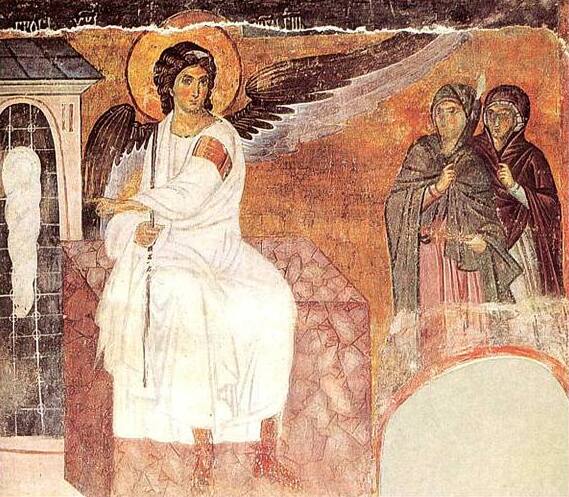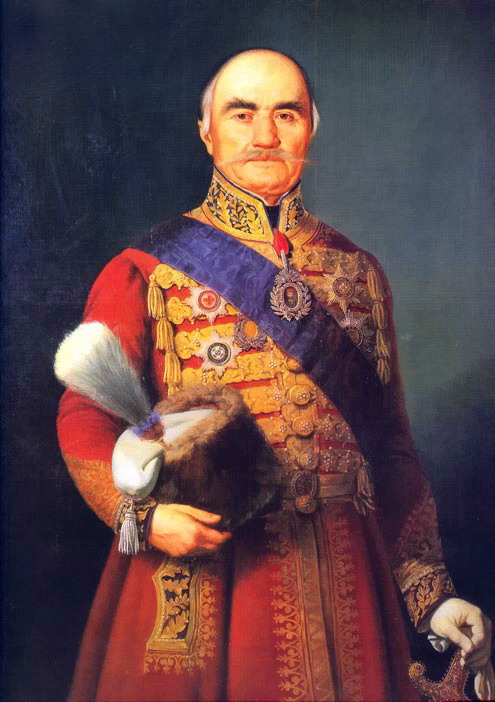|
Pavle Čortanović
Pavle Čortanović (5 February 1830, in Novi Sad, then Habsburg monarchy, now Serbia – 31 March 1903, in Belgrade, Serbia) was a Serbian painter. Pavle was the son and student of Petar Čortanović. Pavle also studied art at the Vienna Academy of Fine Arts from 1845 until the winter semester of 1852–1853. He was the author of many icons that grace the sanctuary screens (iconostasis) of Serbian Orthodox churches in Vojka (1859), Vasica (1863), Bodegraj (1885), and also in Besenov, Ravanica, Grabovo, Stara Pazova, Veliki Radinci, Berkasovo, Ruma, Lalić and other places. He also authored a portrait of Miloš Obrenović, prince and ruler of the Principality of Serbia. Works by Pavle Čortanović can be found in art galleries and museums throughout the country. Also, Čortanović's work can be found in the collection of Milan Jovanović Stojimirović who bequeathed a large number of paintings, sketches, and artifacts to the Art Department of the Museum in Smederevo. Sel ... [...More Info...] [...Related Items...] OR: [Wikipedia] [Google] [Baidu] |
Veliki Radinci
Veliki Radinci () is a village in Serbia. It is situated in the Sremska Mitrovica municipality, in the Syrmia District, Vojvodina province. The village has a Serb ethnic majority and its population numbering 1,426 people (2011 census). Name In Serbian, the village is known as ''Veliki Radinci'' (Велики Радинци), in Croatian as ''Veliki Radinci'', and in Hungarian as ''Radinc''. Its name derived from Serbian words ''veliki'' 'large, big' and ''raditi'' 'to work'. The name of the village in Serbian is plural. Demographics 1282 adult citizens live in the village. The average age of citizens is 39.1 years (37.8 for men and 40.4 for women). There are 607 households and the average number of members per household is 2.66. The majority of citizens are Serbs. See also * List of places in Serbia * List of cities, towns and villages in Vojvodina This is a list of cities, towns and villages in Vojvodina, a province of Serbia , image_flag ... [...More Info...] [...Related Items...] OR: [Wikipedia] [Google] [Baidu] |
19th-century Serbian Painters
The 19th century began on 1 January 1801 (represented by the Roman numerals MDCCCI), and ended on 31 December 1900 (MCM). It was the 9th century of the 2nd millennium. It was characterized by vast social upheaval. Slavery was abolished in much of Europe and the Americas. The First Industrial Revolution, though it began in the late 18th century, expanded beyond its British homeland for the first time during the 19th century, particularly remaking the economies and societies of the Low Countries, France, the Rhineland, Northern Italy, and the Northeastern United States. A few decades later, the Second Industrial Revolution led to ever more massive urbanization and much higher levels of productivity, profit, and prosperity, a pattern that continued into the 20th century. The Catholic Church, in response to the growing influence and power of modernism, secularism and materialism, formed the First Vatican Council in the late 19th century to deal with such problems and confirm cer ... [...More Info...] [...Related Items...] OR: [Wikipedia] [Google] [Baidu] |
1903 Deaths
Events January * January 1 – Edward VII is proclaimed Emperor of India. * January 10 – The Aceh Sultanate was fully annexed by the Dutch forces, deposing the last sultan, marking the end of the Aceh War that have lasted for almost 30 years. * January 19 – The first west–east transatlantic radio broadcast is made from the United States to England (the first east–west broadcast having been made in 1901). February * February 13 – Venezuelan crisis: After agreeing to arbitration in Washington, the United Kingdom, Germany and Italy reach a settlement with Venezuela resulting in the Washington Protocols. The naval blockade that began in 1902 ends. * February 23 – Cuba leases Guantánamo Bay to the United States "in perpetuity". March * March 2 – In New York City, the Martha Washington Hotel, the first hotel exclusively for women, opens. * March 3 – The British Admiralty announces plans to build the Rosyth Dockyard as a naval ... [...More Info...] [...Related Items...] OR: [Wikipedia] [Google] [Baidu] |
1830 Births
It is known in European history as a rather tumultuous year with the Revolutions of 1830 in France, Belgium, Poland, Switzerland and Italy. Events January–March * January 11 – LaGrange College (later the University of North Alabama) begins operation, becoming the first publicly chartered college in Alabama. * January 12 – Webster–Hayne debate: In the United States Congress, Robert Y. Hayne of South Carolina debates against Daniel Webster of Massachusetts about the question of states' rights vs. federal authority. The debate lasts until –January 27. * February 3 – The London Protocol establishes the full independence and sovereignty of Greece from the Ottoman Empire, as the result of the Greek War of Independence. * February 5 – A fire destroys the Argyll Rooms in London, where the Philharmonic Society of London presents concerts, but firefighters are able to prevent its further spread by use of their new equipment, steam-powered fire engines. * March 26 ... [...More Info...] [...Related Items...] OR: [Wikipedia] [Google] [Baidu] |
Serbian Art
Serbian art refers to the visual arts of the Serbs and their nation-state Serbia. The medieval heritage includes Byzantine art, preserved in architecture, frescos and icons of the many Serbian Orthodox monasteries. In the early modern period, Serbian visual arts began to be influenced by Western art, culminating in the Habsburg monarchy in the late 18th century. The beginning of modern Serbian art is placed in the 19th century. Many Serbian monuments and works of art have been lost forever due to various wars and peacetime marginalizations. Prehistory Currently, Europe's oldest known civilization was discovered in Serbia, namely Lepenski Vir and Vinča culture. In Serbia, Archaeological Sites of Exceptional Importance (Serbia) are numerous and have the highest level of state protection under the Law on Cultural Heritage. See: Prehistoric sites in Serbia and Prehistory of Southeastern Europe for artifacts and sculpture found at the archeological sites of Lepenski Vir. Roman pe ... [...More Info...] [...Related Items...] OR: [Wikipedia] [Google] [Baidu] |
List Of Painters From Serbia
This is a list of notable Serbian painters. A * Nikola Aleksić (1808–1873) * Dimitrije Avramović (1815–1855) * Ljubomir Aleksandrović (1828–1890) * Stevan Aleksić (1876–1923) * Dragomir Arambašić (1881–1945) * Stojan Aralica (1883–1980) * Đorđe Andrejević Kun (1904–1964) * Mika Antić (1932–1986) * Dragoslav Pavle Aksentijević (born 1942) * Marina Abramović (born 1946) * Nataša Atanasković (born 1972) * Emanuil Antonovich (1785–1829) B * Nikola Božidarević (1460–1517) * Dimitrije Bačević (1735–1770) * Georgije Bakalović (1786–1843) * Anastas Bocarić (1864–1944) * Špiro Bocarić (1876–1941) * Jovan Bijelić (c.1884–1964) * Ilija Bašičević (1895–1972) * Oto Bihalji-Merin (1904–1993) * Dimitrije Bratoglic (1765–1831) * Janko Brašić (1906–1994) * Miloš Bajić (1915–1995) * Radivoj Berbakov (1925–2003) * Kossa Bokchan (1925–2009) * Ivana Bašić (born 1986) * Bogdan Bulajić (born 1940) C ... [...More Info...] [...Related Items...] OR: [Wikipedia] [Google] [Baidu] |
Smederevo
Smederevo ( sr-Cyrl, Смедерево, ) is a list of cities in Serbia, city and the administrative center of the Podunavlje District in eastern Serbia. It is situated on the right bank of the Danube, about downstream of the Serbian capital, Belgrade. According to the 2022 census, the city has a population of 59,261, with 97,930 people living in its administrative area. Its history starts in the 1st century BC, after the conquest of the Roman Empire, when there existed a settlement by the name of Vinceia. The modern city traces its roots back to the Late Middle Ages when it was the capital (1430–39, and 1444–59) of the last Serbian Despotate, independent Serbian state before Ottoman Empire, Ottoman conquest. Smederevo is said to be the city of iron ( sr-Cyrl-Latn, гвожђе, gvožđe, separator=" / ", label=none) and grapes ( sr-Cyrl-Latn, грожђе, grožđe, separator=" / ", label=none). Names In Serbian language, Serbian, the city is known as ''Smederevo'' ... [...More Info...] [...Related Items...] OR: [Wikipedia] [Google] [Baidu] |
Milan Jovanović Stojimirović
Milan Jovanović Stojimirović (Smederevo, Kingdom of Serbia, 19 June 1898 – Belgrad, Serbia, Yugoslavia, 6 March 1966) was a Serbian journalist, diplomat, manager of the Archive of Serbia, and chronicler of Old Belgrade. His vast collection of paintings, sculptures and artifacts were bequeathed to the Museum and National Library in Smederevo. Childhood and youth He was born in Smederevo to father Svetozar Jovanović, a shoemaker, and mother Jelena nee Stojimirović. He lost his father early, so his mother Jelena and uncle Dr. Dušan Stojimirović (1870–1956) took care of him and his younger brother Ivan. Out of gratitude, both brothers added Stojimirović to their surname. He finished elementary school in Smederevo and high school in Smederevo and Belgrade. During the First World War, he stayed in Belgrade with his uncle, Dr. Dušan Stojimirović, who was the manager of the mental hospital. There he met Petar Kočić and wrote an article about it published in 1922 in the Se ... [...More Info...] [...Related Items...] OR: [Wikipedia] [Google] [Baidu] |
Principality Of Serbia
The Principality of Serbia () was an autonomous, later sovereign state in the Balkans that came into existence as a result of the Serbian Revolution, which lasted between 1804 and 1817. Its creation was negotiated first through an unwritten agreement between Miloš Obrenović, leader of the Second Serbian Uprising, and Ottoman official Marashli Pasha. It was followed by the series of legal documents published by the Sublime Porte in 1828, 1829 and finally, 1830—the Hatt-i Sharif. Its ''de facto'' independence ensued in 1867, following the evacuation of the remaining Ottoman troops from the Belgrade Fortress and the country; its independence was recognized internationally in 1878 by the Treaty of Berlin. In 1882 the country was elevated to the status of kingdom. Background and establishment The Serbian revolutionary leaders—first Karađorđe and then Miloš Obrenović—succeeded in their goal of liberating Serbia from centuries-long Turkish rule. Turkish authoriti ... [...More Info...] [...Related Items...] OR: [Wikipedia] [Google] [Baidu] |
Miloš Obrenović
Miloš Obrenović (; ; 18 March 1780 or 1783 – 26 September 1860) born Miloš Teodorović (; ), also known as Miloš the Great () was the Prince of Serbia twice, from 1815 to 1839, and from 1858 to 1860. He was an eminent figure of the First Serbian uprising, the leader of the Second Serbian uprising, and the founder of the house of Obrenović. Under his rule, Serbia became an autonomous principality within the Ottoman Empire. Prince Miloš was an autocrat, consistently refusing to decentralize power, which gave rise to a strong internal opposition. Despite his humble background, he eventually became the most affluent man in Serbia and one of the wealthiest in the Balkans, possessing estates in Vienna, Serbia and Wallachia. During his rule, Miloš bought a certain number of estates and ships from the Ottomans and was also a prominent trader. Early life Miloš Teodorović was the son of Teodor "Teša" Mihailović (died 1802) from Dobrinja, and Višnja (died 18 June 1817). ... [...More Info...] [...Related Items...] OR: [Wikipedia] [Google] [Baidu] |
Lalić, Serbia
Lalić (Serbian Cyrillic: Лалић; ) is a village in Serbia. It is situated in the Odžaci municipality in the West Bačka District, Vojvodina province. The village is ethnically mixed and has population of 1,646 people (2002 census), including several ethnic groups, among them 796 Slovaks, 702 Serbs, and others. Its twin town is Mošovce (Slovakia). Historical population *1961: 2,352 *1971: 2,125 *1981: 1,859 *1991: 1,699 *2014: 1.423 See also *List of places in Serbia *List of cities, towns and villages in Vojvodina This is a list of cities, towns and villages in Vojvodina, a province of Serbia , image_flag = Flag of Serbia.svg , national_motto = , image_coat = Coat of arms of Serbia.svg , national_anthem = ... References *Slobodan Ćurčić, Broj stanovnika Vojvodine, Novi Sad, 1996. External links Lalić Places in Bačka West Bačka District Odžaci {{WestBačkaRS-geo-stub ... [...More Info...] [...Related Items...] OR: [Wikipedia] [Google] [Baidu] |




